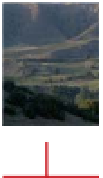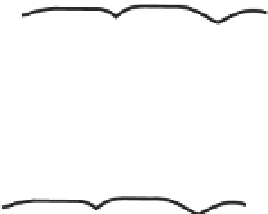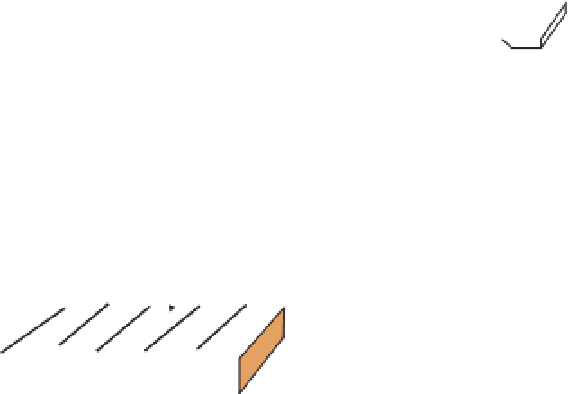Geology Reference
In-Depth Information
corresponds to the sense of shear
of the main fabric. A porphyroblast
subjected to shear may grow a 'tail' of
small crystals at one or both sides of
the object that point towards the shear
direction (Figure 7.4D, 7.5C). This is
termed
sigma structure
because of
its similarity to the Greek letter sigma
(V). If the sheared object rotates in the
same sense as the overall shear direc-
tion, this gives further evidence of
shear sense. However, rotated sigma
structure results in the tail of the por-
phyroblast being bent round in such a
way that it eventually appears on the
opposite side of the porphyroblast, as
shown in Figure 7.4E. This is termed
delta structure
, after the Greek letter
delta (G). Since the tail now appears
to indicate the opposite shear sense,
care must be taken to distinguish
between these two types of structure.
Rotated porphyroblasts often contain
an internal fabric that is another source
of evidence for the sense of rotation.
Garnets are a well-known example of
this phenomenon (Figures 7.4F, 7.5D);
the sense of rotation is even more
obvious when the garnet continues to
grow during the shearing process, in
which case the internal fabric displays
an 'S' or 'Z' shape due to the fact that the
last-grown fabric is continuous with the
main foliation, whereas the earlier fabric
has rotated (Figure 7.4G). It is impor-
tant to recognise that any perceived
rotation is only relative to the enclos-
ing foliation, which itself may have
rotated relative to the shear direction.
In interpreting asymmetric fabrics,
these should be viewed as nearly as
possible in a plane perpendicular
to the main foliation and parallel to
the inferred shear direction, which
will often be visible in the form of an
elongation lineation on the foliation
surfaces. Viewing fabrics at a high
angle to the shear direction will give
conflicting or misleading asymmetries.
7
62
63
Lineations
There are several different kinds of lin-
eation, not all of which are structurally
significant. A
lineation
is merely a set
of parallel lines on the surface of a rock,
or which pass through it. Surface linea-
tions, unless they lie on a fabric plane,
are difficult to interpret; they usually
indicate the intersection of bedding or
foliation on a random surface such as
a joint, and have no structural signifi-
cance in themselves. However, surface
lineations on two non-parallel surfaces
may be used to reconstruct the orienta-
tion of the intersecting planar structure,
as shown in Figure 7.6A.
fault
plane
bedding plane
intersection
lineation
intersection
lineation
A
B
slickenside
surface
slickenfibres
slickenlines
C
Figure 7.6
Lineations.
A.
Intersection lineations
produced on two vertical outcrop surfaces at
their intersection with bedding.
B.
Slickenfibres
(green) produced by the growth of crystals in
a gap between two moving fault walls.
C.
One
side of the fault showing the slickenfibres and
also slickenlines (grooves) on the slickenside
fault surface.
D.
Cuspate structure produced
by compression of an interface between
stronger and weaker rock layers; and
E
, in three
dimensions, this produces mullion structure.
F.
Boudinage (pull-apart structure) caused by
the extension of a stronger layer within weaker
material; and
G
, in three dimensions, the boudins
also form mullion-like structures.
weaker
weaker
stronger
stronger
D
F
mullions
boudins
G
E






































































Search WWH ::

Custom Search